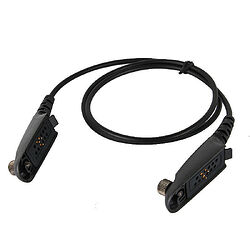Non-specifically to any make/model or defined radio and cables :-
Cables come in three main configurations (not counting connector variations). The simplest (and rare beasts these days) are simple wired ones where a TTL signalling or suchlike uses the cable merely as a medium, all UART functions being contained in host and slave devices. These were common many moons ago and either were TTL level, or were 5v signalled RS232 and a simple binary or plain text exchanged happened. The pure TTL ones usually had a dedicated TTL UART port on the programmer (essentially a JTAG port).
Next up, you’ll find (as was common on many USB and none USB phone cables which terminated device end in many connector types) that the cable had a UART embedded inline that was the device’s external UART to enable the device to talk to the programmer device’s USB/RS232/bidirectional Parallel port.
Those UART embedded types mostly got superceded by USB-USB cables outside of the radio world, in the radio world, a lot became USB->UART to a JTAG style communication on device.
And then you have USB UART enabled devices that use a USB to USB breakout (much like phones) which are mostly identified by a micro USB port on the device - worth noting, the command over the mic/ear sockets (JTAG serial) is still present on such devices, mostly used by cloning cables.
Noting that, none of the above are interchangeable, whatever config the OEM cable uses has to be present, but on the older types, you could just cut and swap the device end wiring or make an inline adapter for.
So the thing is you’ve got to make sure it’s the right kind, and vague makes lists of compatible claims mean nothing.
If the cable supports known series of a given make (and clones, since some radios are mere rehashed OEM devices) of the make you need and you can determine your radio uses the same setup, protocol as well, then it’s probably OK.
I miss the days when cables were simply plugs and wires, rewiring a plug and possibly a level drop resistor made life way easier than finding the right driver, compensating for pattern note fully implemented UART clones and such madness.
But I’m old school.
